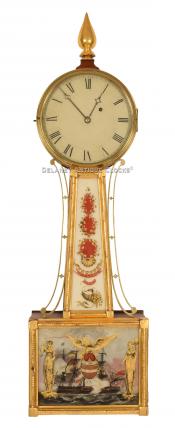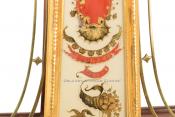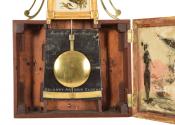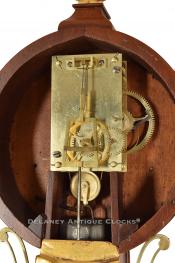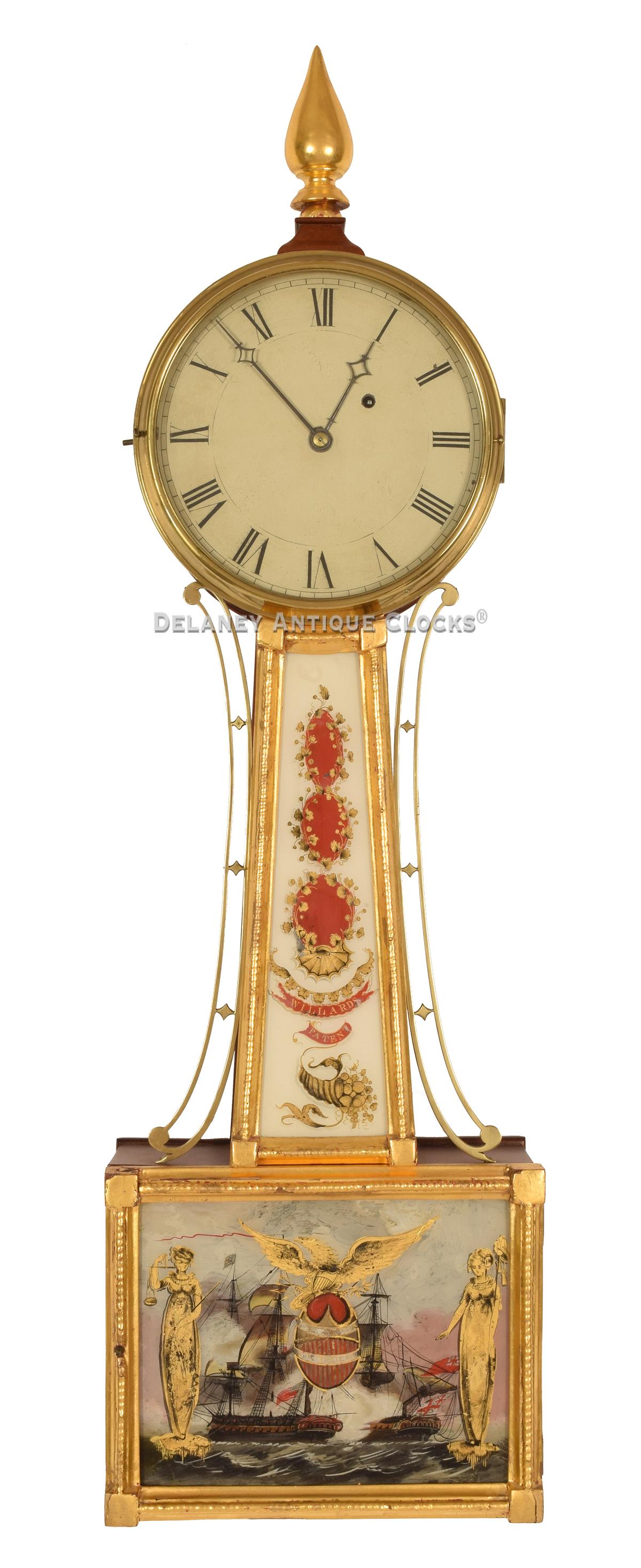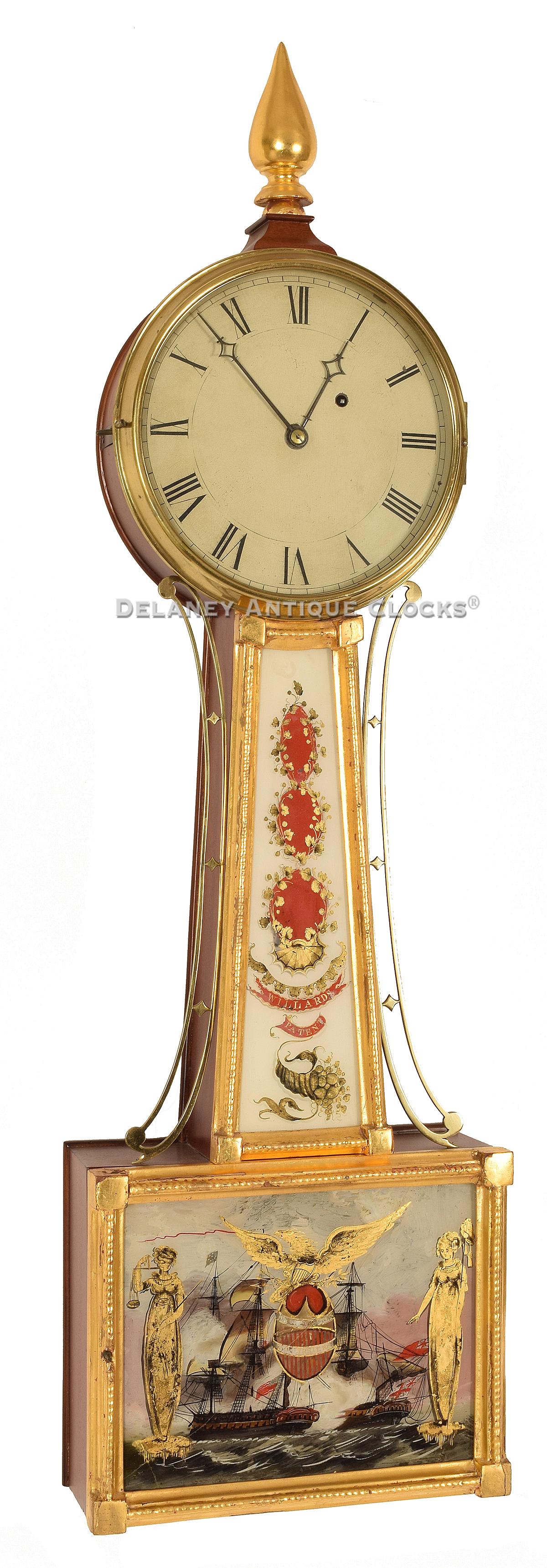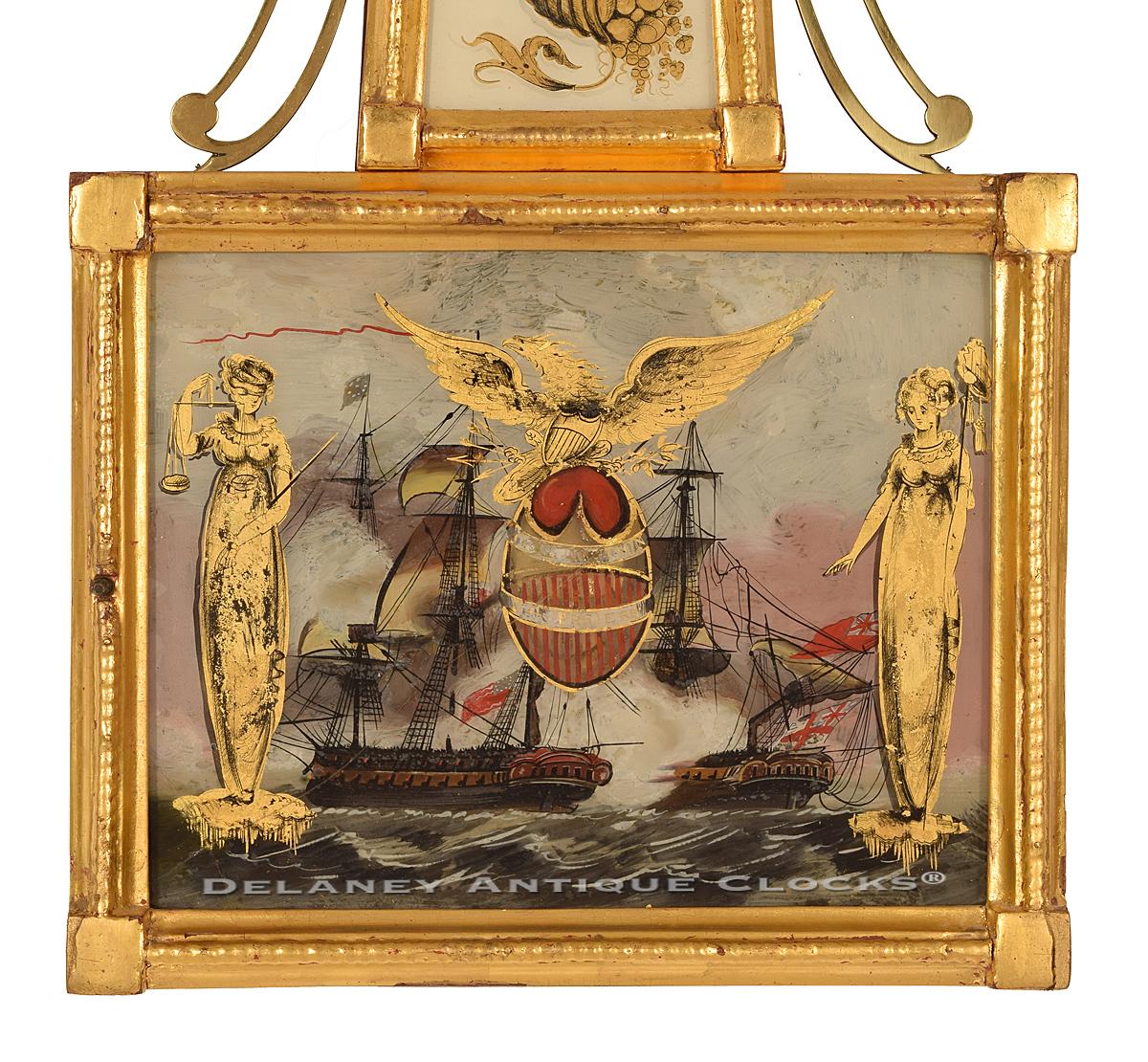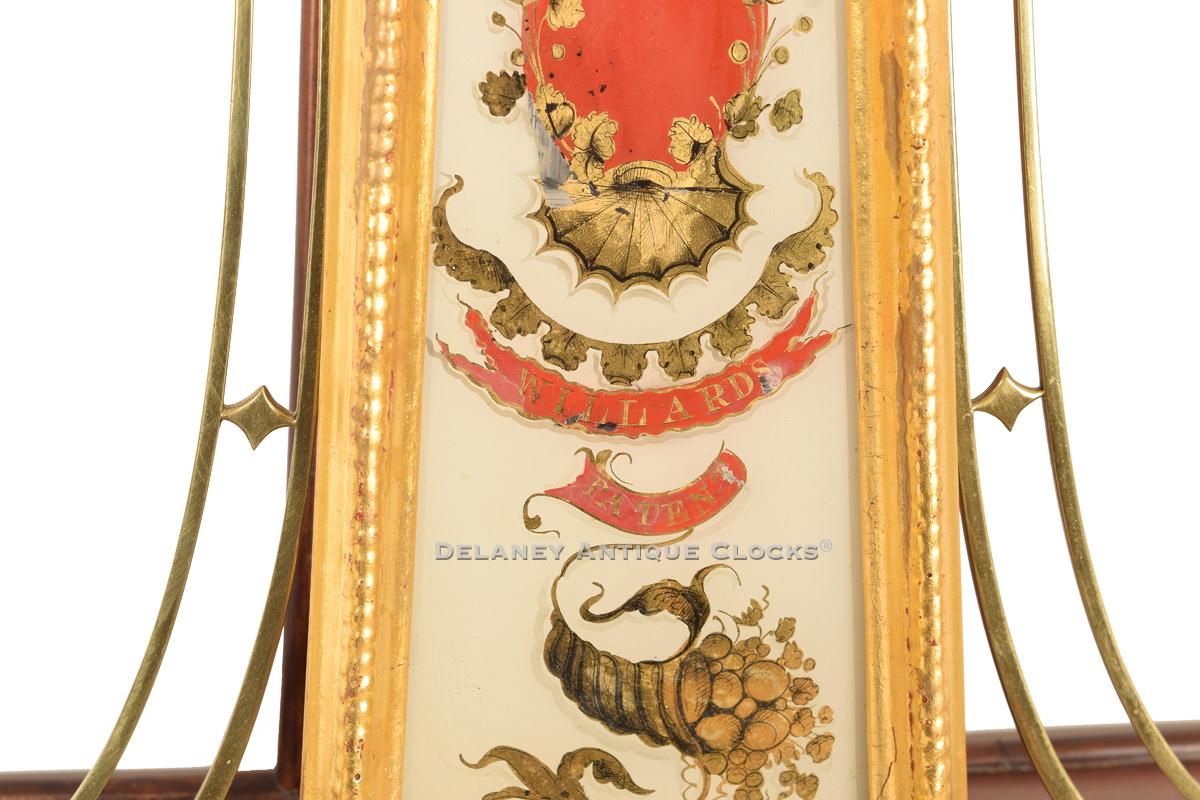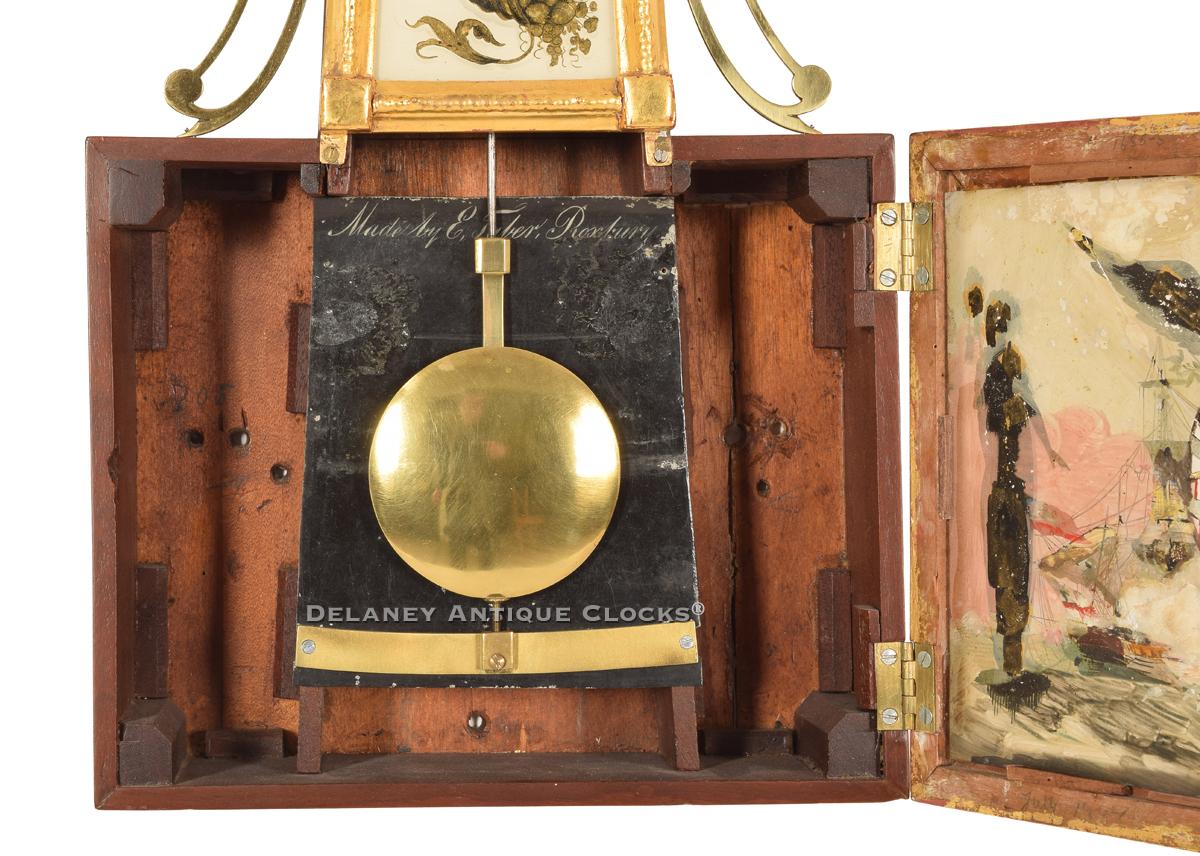Elnathan Taber Roxbury, Massachusetts. A gilt frame timepiece with exceptional tablets commemorating the naval battle between the Constitution and the Guerriere. 222003.
The strength of this timepiece is the subject matter, and the quality of the reverse painted tablets. Both tablets are mounted in gilded rope frames. The lower tablet is complex. The primary theme is Independence. The background of this tablet depicts the Naval battle between the Constitution and Guerriere. This battle took place during the War of 1812. The U.S. Frigate Constitution's Commanding Officer, Isaac Hull, engaged and defeated Captain James R. Dacres of the Guerriere off the coast of Halifax, Nova Scotia, on August 19th, 1812. This battle was one of the most celebrated American victories of the war. Silhouetted against the smoke from the cannon fire are the hapless British sailors and the jubilant Americans, who brandish swords. According to tradition, during this battle, the Constitution earned the nickname "Old Ironsides." Seeing that cannonballs seemed to bounce off the ship's thick, oak hull. This glass is titled in the banners below the eagle on the shield. This shield has areas that are left undecorated or clear. Looking through these clear areas, one can see the pendulum's motion when the clock is running. Above this is the nation's symbol for unity. E. Pluribus Unum, translating in Latin to mean "Out of many, one." The thirteen colonies were united to fight the British Crown. The American eagle is depicted with its wings in an outstretched position. As if it is ready to take flight. This patriotic symbol is carrying an American shield on its chest. Its claws are clutching the arrows of war on the lower left and the holly branches of peace on the lower right. The Eagle is positioned with its head turned in the direction of war. Two full-figured women are positioned on the sides of the glass. They are also painted in gilt. On the left is a blindfolded woman representing Justice. Lady Justice holds a set of scales in her right hand and a sword in her right. The opposing figure symbolizes Freedom. She holds a Liberty Pole topped with the Liberty Cap in her left hand. The throat tablet is decorated with traditional themes that include a cornucopia, the horn of plenty, a fan, and three medallions. The banners here read "WILLARDS / PATENT." This pays homage to Simon Willard's 1802 patent for this wall timepiece design. Willard licensed Elnathan Taber to make this form during the patent period.
This timepiece case is constructed in mahogany. The dial bezel and shapely sidearms are cast in brass. The dial bezel closes on the case with a push-button latch. This bezel is fitted with glass and opens to access the painted iron dial. The hour and minute hands are filed and shaped. They display the time. The time ring features a closed minute ring along the dial's perimeter. Roman-style hour numerals demark each hour. The small hole in the dial is used to access the movement with a key to wind the clock.
The movement is weight-driven and designed to run for eight days on a full wind. The movement is constructed in brass. It is mounted to the back of the case with two through-bolts or screws through the backplate. These are diagonally positioned. Four brass pillars secure the rectangular-shaped plates. The front plate is engraved numerous times by the repairman that serviced this clock. Several of these are done by Elnathan Taber himself. Hardened steel shafts support the brass gearing. The teeth in the gear train are deeply cut. The click is nicely shaped. The pendulum hangs from a T-bridge mounted to the front of the movement. The pendulum is constructed with a steel rod that supports a brass-faced bob. A tin weight shield located in the lower box of the case guides the weight away from the pendulum. This clock is signed by the Clockmaker in this location. Inscribed on the weight tin in script, the Maker wrote, "Made by E. Taber, Roxbury."
This beautiful clock measures approximately 33.5 inches long and was made circa 1825.
It is inventory number 222003.
Elnathan Taber was born in Dartmouth, Massachusetts, on February 14, 1768, and may have died in Dartmouth, Massachusetts, on February 27, 1854, at the age of 86. His grave was moved from Dartmouth to Forest Hills Cemetery in Jamaica Plain on October 29, 1870. His parents were Thomas and Elizabeth (Swift) Taber. Elnathan is the older brother of Stephen Taber, whose fortune helped found Taber Academy in Marion, MA. Both brothers traveled to Roxbury and were trained as clockmakers by the Willards. Elnathan was just 16. After serving his apprenticeship, Elnathan stayed and worked in Roxbury. His shop was located on Union Street. Union Street was renamed Taber Street in April 1868 in his honor. He was the first resident of that street. William Cummens also moved there and set up shop at the corner of Winslow. This short street was between Warren Street and Winslow Street. Elnathan maintained a close working relationship with his mentor Simon and became one of his most famous apprentices. He was authorized by Simon to make his patent timepieces during the patent period. He was also a prolific repairman. His name can be found engraved on numerous Boston area-made clocks as a service record. Elnathan married Catherine Partridge in January 1797. They had four children between the years of 1797 and 1811. Catherine had three sisters who also married clockmakers. Her sister Elizabeth married Abel Hutchins, and Mary (Polly) married Aaron Willard. A third sister married Samuel Curtis. Over the years, we have owned and sold numerous tall case clocks made by this fine clockmaker. In addition, we have owned a good number of wall timepieces in the form of banjo clocks and coffin clocks, as well as several of the Massachusetts shelf clock forms.

